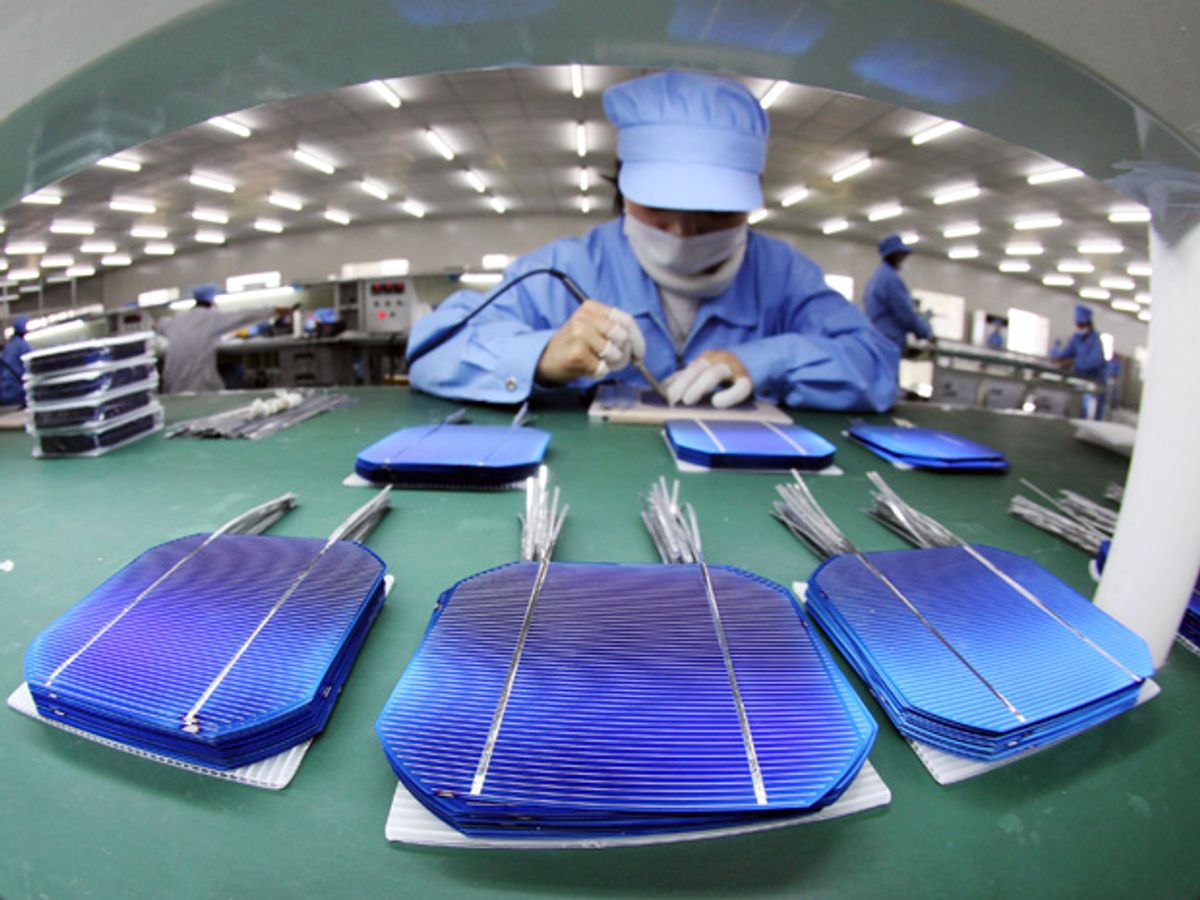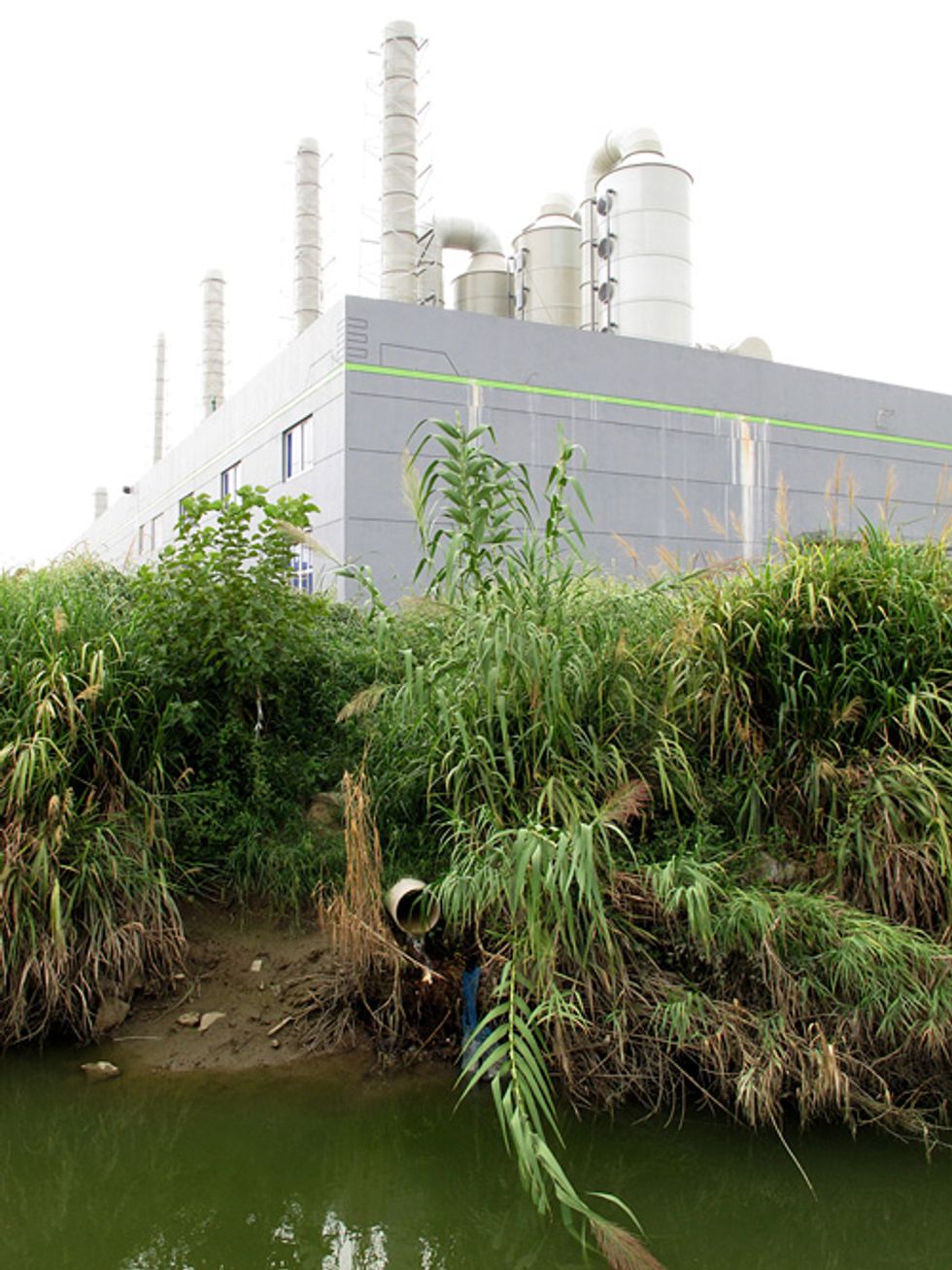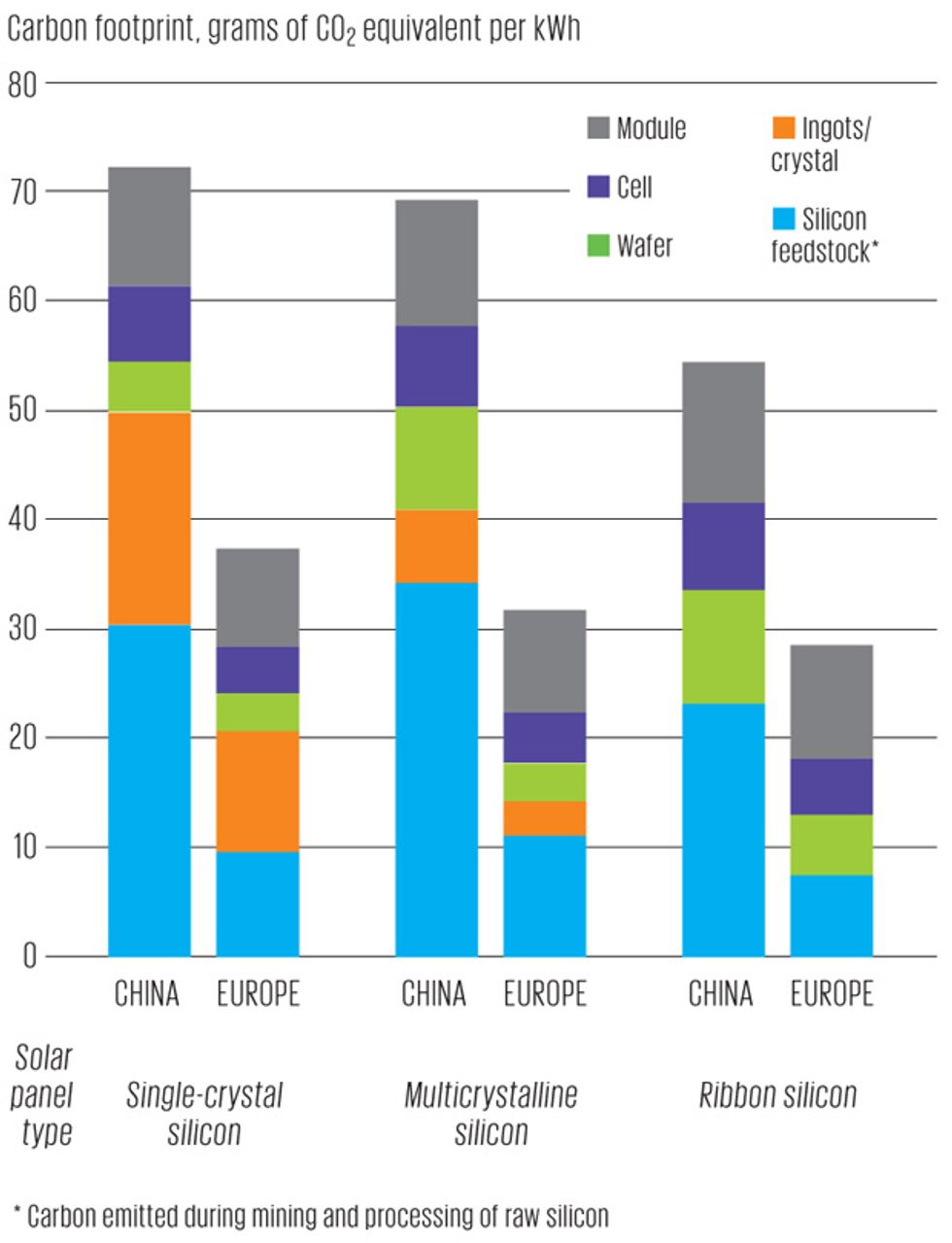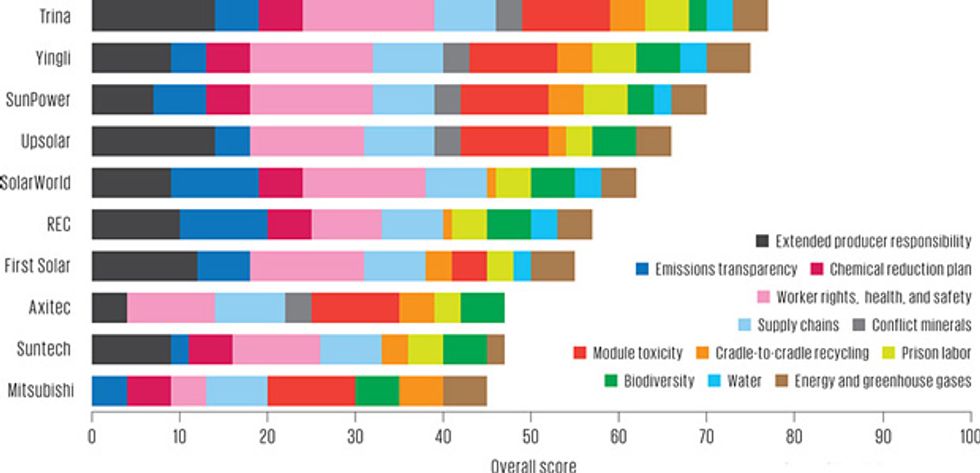Solar Energy Isn’t Always as Green as You Think
Do cheaper photovoltaics providing solar energy come with a higher environmental price tag?

Solar panels glimmering in the sun are an icon of all that is green. But while generating electricity through photovoltaics is indeed better for the environment than burning fossil fuels, several incidents have linked the manufacture of these shining symbols of environmental virtue to a trail of chemical pollution. And it turns out that the time it takes to compensate for the energy used and the greenhouse gases emitted in photovoltaic panel production varies substantially by technology and geography.
That's the bad news. The good news is that the industry could readily eliminate many of the damaging side effects that do exist. Indeed, pressure for it to do so is mounting, in part because, since 2008, photovoltaics manufacturing has moved from Europe, Japan, and the United States to China, Malaysia, the Philippines, and Taiwan; today nearly half the world's photovoltaics are manufactured in China. As a result, although the overall track record for the industry is good, the countries that produce the most photovoltaics today typically do the worst job of protecting the environment and their workers.
To understand exactly what the problems are, and how they might be addressed, it's helpful to know a little something about how photovoltaic panels are made. While solar energy can be generated using a variety of technologies, the vast majority of solar cells today start as quartz, the most common form of silica (silicon dioxide), which is refined into elemental silicon. There's the first problem: The quartz is extracted from mines, putting the miners at risk of one of civilization's oldest occupational hazards, the lung disease silicosis.
The initial refining turns quartz into metallurgical-grade silicon, a substance used mostly to harden steel and other metals. That happens in giant furnaces, and keeping them hot takes a lot of energy, a subject we'll return to later. Fortunately, the levels of the resulting emissions—mostly carbon dioxide and sulfur dioxide—can't do much harm to the people working at silicon refineries or to the immediate environment.
The next step, however—turning metallurgical-grade silicon into a purer form called polysilicon—creates the very toxic compound silicon tetrachloride. The refinement process involves combining hydrochloric acid with metallurgical-grade silicon to turn it into what are called trichlorosilanes. The trichlorosilanes then react with added hydrogen, producing polysilicon along with liquid silicon tetrachloride—three or four tons of silicon tetrachloride for every ton of polysilicon.
Most manufacturers recycle this waste to make more polysilicon. Capturing silicon from silicon tetrachloride requires less energy than obtaining it from raw silica, so recycling this waste can save manufacturers money. But the reprocessing equipment can cost tens of millions of dollars. So some operations have just thrown away the by-product. If exposed to water—and that's hard to prevent if it's casually dumped—the silicon tetrachloride releases hydrochloric acid, acidifying the soil and emitting harmful fumes.
When the photovoltaics industry was smaller, the solar-cell manufacturers got their silicon from chipmakers, which rejected wafers that did not meet the computer industry's purity requirements. But the boom in photovoltaics demanded more than semiconductor-industry leftovers, and many new polysilicon refineries were built in China. Few countries at the time had stringent rules covering the storage and disposal of silicon tetrachloride waste, and China was no exception, as some Washington Post reporters discovered.
The paper's investigation, published in March 2008, profiled a Chinese polysilicon facility owned by Luoyang Zhonggui High-Technology Co., located near the Yellow River in the country's Henan province. This facility supplied polysilicon to Suntech Power Holdings, at the time the world's largest solar-cell manufacturer, as well as to several other high-profile photovoltaics companies.
The reporters found that the company was dumping silicon tetrachloride waste on neighboring fields instead of investing in equipment that could reprocess it, rendering those fields useless for growing crops and inflaming the eyes and throats of nearby residents. And the article suggested that the company was not alone in this practice.
After the publication of the Washington Post story, solar companies' stock prices fell. Investors feared the revelations would undermine an industry that relies so much on its green credentials. After all, that's what attracts most customers and draws public support for policies that foster the adoption of solar energy, such as the Residential Renewable Energy Tax Credit in the United States. Those who purchase residential solar systems can subtract 30 percent of the cost from their tax bills until the incentive expires in 2016.
To protect the industry's reputation, the manufacturers of photovoltaic panels began to inquire about the environmental practices of their polysilicon suppliers. Consequently, the situation is now improving. In 2011 China set standards requiring that companies recycle at least 98.5 percent of their silicon tetrachloride waste. These standards are easy to meet so long as factories install the proper equipment. Yet it remains to be seen how well the rules are being enforced.
This problem could completely go away in the future. Researchers at the National Renewable Energy Laboratory in Golden, Colo., are looking for ways to make polysilicon with ethanol instead of chlorine-based chemicals, thereby avoiding the creation of silicon tetrachloride altogether.
The struggle to keep photovoltaics green does not end with the production of polysilicon. Solar-cell manufacturers purify chunks of polysilicon to form bricklike ingots and then slice the ingots into wafers. Then they introduce impurities into the silicon wafers, creating the essential solar-cell architecture that produces the photovoltaic effect.
These steps all involve hazardous chemicals. For example, manufacturers rely on hydrofluoric acid to clean the wafers, remove damage that comes from sawing, and texture the surface to better collect light. Hydrofluoric acid works great for all these things, but when it touches an unprotected person, this highly corrosive liquid can destroy tissue and decalcify bones. So handling hydrofluoric acid requires extreme care, and it must be disposed of properly.
But accidents do happen and are more likely in places that have limited experience manufacturing semiconductors or that have lax environmental regulations. In August 2011, a factory in China's Zhejiang province owned by Jinko Solar Holding Co., one of the largest photovoltaic companies in the world, spilled hydrofluoric acid into the nearby Mujiaqiao River, killing hundreds of fish. And farmers working adjacent lands, who used the contaminated water to clean their animals, accidently killed dozens of pigs.
In investigating the dead pigs, Chinese authorities found levels of hydrofluoric acid in the river 10 times the permitted limit, and they presumably took these measurements long after much of the hydrofluoric acid had washed downstream. Hundreds of local residents, upset over the incident, stormed and temporarily occupied the manufacturing facility. Again, investors reacted: When major media outlets carried the news the next day, Jinko's stock price dropped by more than 40 percent, translating to nearly US $100 million in lost value.
This threat to the environment needn't continue. Researchers at Rohm & Haas Electronic Materials, a subsidiary of Dow Chemical, have identified substitutes for the hydrofluoric acid used in solar-cell manufacture. One good candidate is sodium hydroxide (NaOH). Although NaOH is itself a caustic chemical, it is easier to treat and dispose of than hydrofluoric acid and is less risky for workers. It is also easier to treat wastewater containing NaOH.
Although more than 90 percent of photovoltaic panels made today start with polysilicon, there is a newer approach: thin-film solar-cell technology. The thin-film varieties will likely grow in market share over the next decade, because they can be just as efficient as silicon-based solar cells and yet cheaper to manufacture, as they use less energy and material.
Makers of thin-film cells deposit layers of semiconductor material directly on a substrate of glass, metal, or plastic instead of slicing wafers from a silicon ingot. This produces less waste and completely avoids the complicated melting, drawing, and slicing used to make traditional cells. In essence, a piece of glass goes in at one end of the factory and a fully functional photovoltaic module emerges from the other.
Moving to thin-film solar cells eliminates many of the environmental and safety hazards from manufacturing, because there's no need for certain problematic chemicals—no hydrofluoric acid, no hydrochloric acid. But that does not mean you can automatically stamp a thin-film solar cell as green.
Today's dominant thin-film technologies are cadmium telluride and a more recent competitor, copper indium gallium selenide (CIGS). In the former, one semiconductor layer is made of cadmium telluride; the second is cadmium sulfide. In the latter, the primary semiconductor material is CIGS, but the second layer is typically cadmium sulfide. So each of these technologies uses compounds containing the heavy metal cadmium, which is both a carcinogen and a genotoxin, meaning that it can cause inheritable mutations.
Manufacturers like First Solar, based in Tempe, Ariz., have a strong record of protecting workers from cadmium exposures during manufacture. But there is little information about exposures to workers involved with cadmium at earlier stages in the life cycle of the metal, from the zinc mines where much of cadmium originates through the smelting process that purifies cadmium and turns it into semiconductor materials. Exposures after solar panels are discarded are also a concern. Most of the cadmium telluride that manufacturers dispose of due to damage or manufacturing defects is recycled under safe, controlled conditions. On the postconsumer end of the equation, the industry proactively set up a solar-panel collection and recycling scheme in Europe. Individual companies have also established recycling programs, such as First Solar's prefunded take-back system. But more needs to be done; not every consumer has access to a free take-back program, and indeed many consumers may not even be aware of the need to dispose of panels responsibly.
The best way to avoid exposing workers and the environment to toxic cadmium is to minimize the amount used or to use no cadmium at all. Already, two major CIGS-photovoltaic manufacturers—Avancis and Solar Frontier—are using zinc sulfide, a relatively benign material, instead of cadmium sulfide. And researchers from the University of Bristol and the University of Bath, in England; the University of California, Berkeley; and many other academic and government laboratories are trying to develop thin-film photovoltaics that do not require toxic elements like cadmium or rare elements like tellurium. First Solar has meanwhile been steadily reducing the amount of cadmium used in its solar cells.
Toxicity isn't the only concern. Making solar cells requires a lot of energy. Fortunately, because these cells generate electricity, they pay back the original investment of energy; most do so after just two years of operation, and some companies report payback times as short as six months. This “energy payback" time is not the same as the time needed to recoup a consumers financial investment in solar panels; it measures investments and payback times in terms of kilowatt-hours, not in terms of money.
Analysts also judge the impact of the energy used to make a solar panel by the amount of carbon generated in the production of that energy—a number that can vary widely. To do this, we give the energy a carbon-intensity value, usually represented as kilograms of CO2 emitted per kilowatt-hour generated. Places that depend largely on coal have the most carbon-intense electricity in the world: Chinese electricity is a good example, having roughly twice the carbon intensity of U.S. electricity. This fits with the results of researchers in Illinois at Argonne National Laboratory and Northwestern University. In a report published this past June, they found that the carbon footprint of photovoltaic panels made in China is indeed about double that of those manufactured in Europe.
If the photovoltaic panels made in China were installed in China, the high carbon intensity of the energy used and that of the energy saved would cancel each other out, and the time needed to counterbalance greenhouse-gas emissions during manufacture would be the same as the energy-payback time. But that's not what's been happening lately. The manufacturing is mostly located in China, and the panels are often installed in Europe or the United States. At double the carbon intensity, it takes twice as long to compensate for the greenhouse-gas emissions as it does to pay back the energy investments.
Of course, if you manufacture photovoltaic panels with low-carbon electricity (for example, in a solar-powered factory) and install them in a high-carbon-intensity country, the greenhouse-gas-payback time will be lower than the energy-payback time. So perhaps someday, powering photovoltaic-panel manufacturing with wind, solar, and geothermal energy will end concerns about the carbon footprint of photovoltaics.
Water is yet another issue. Photovoltaic manufacturers use a lot of it for various purposes, including cooling, chemical processing, and air-pollution control. The biggest water waster, though, is cleaning during installation and use. Utility-scale projects in the 230- to 550-megawatt range can require up to 1.5 billion liters of water for dust control during construction and another 26 million liters annually for panel washing during operation. However, the amount of water used to produce, install, and operate photovoltaic panels is significantly lower than that needed to cool thermoelectric fossil- and fissile-power plants.
The choices investors and consumers make could, in principle, have a big influence on photovoltaic manufacturers' practices. But it's often tough to tell how these companies differ in the care they take to protect the environment. The solar industry has no formal ecolabel, like the Energy Star labels on household appliances and consumer electronics that help U.S. buyers identify energy-efficient products. And most people do not go out and purchase solar panels themselves. They hire third-party installers. So even if there were an ecolabeling scheme, it would depend on installers' willingness to choose ecofriendly products.
For now, consumers can help push manufacturers to improve their environmental and safety records by asking installers about the companies making the products they use. This, in turn, would prompt installers to ask the manufacturers for more information.
Researchers at the National Photovoltaics Environmental Research Center at Brookhaven National Laboratory in Upton, N.Y., have long been publishing studies about the possible environmental hazards of photovoltaics. Recently, formal environmental performance ratings for the solar industry have started to emerge.
Organizations such as the Center for International Earth Science Information Network are trying to establish some means of determining the environmental, health, and safety performance of manufacturers in developing countries. This group, which includes researchers from Yale and Columbia, is proposing the China Environmental Performance Index, which would operate at the provincial level to help China track progress toward environmental-policy goals.
Meanwhile, the Solar Energy Industries Association, a U.S. national trade organization, has proposed new industry guidelines in a document called the “Solar Industry Environment & Social Responsibility Commitment," aimed at preventing occupational injury and illness, preventing pollution, and reducing the natural resources used in production. The document urges companies to ask suppliers to report on manufacturing practices and any chemical and greenhouse-gas emissions.
In addition, the Silicon Valley Toxics Coalition, which rates the environmental performance of electronics companies, has surveyed and ranked photovoltaic manufacturing companies based or operating in China, Germany, Malaysia, the Philippines, and the United States. Participation is voluntary and so far includes such major manufacturers as First Solar, SolarWorld, SunPower, Suntech, Trina, and Yingli; Chinese manufacturers Trina and Yingli have consistently ranked among the world's top three most environmentally responsible companies. And Sharp, SolarWorld, and SunPower have been carefully tracking the greenhouse gases emitted and chemicals used in the manufacture of their solar panels for several years.
Such initiatives are coming none too soon. Many people today view photovoltaics as a panacea for our energy woes, given how dirty most of the alternatives are. But that does not mean we should turn a blind eye to the darker side of this technology. Indeed, we need to consider it very carefully. And just maybe, with a sustained effort by consumers, manufacturers, and researchers, the photovoltaics industry will one day be truly, not just symbolically, green.
This article originally appeared in print as “Solar's Green Dilemma."
This article was updated 12 November 2014.
About the Author
Dustin Mulvaney is an assistant professor of environmental studies at San Jose State University, in California, where he concentrates on the solar-energy, biofuel, and natural-gas industries. Although he identifies himself as both a solar advocate and a solar user—he has a photovoltaic array in his yard—his research has made him mindful of the significant health risks and environmental costs of manufacturing PV panels.


